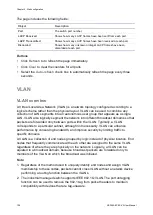
Chapter 4: Web configuration
108
NS3552-8P-2S-V2 User Manual
IEEE 802.1Q standard
IEEE 802.1Q (tagged) VLAN are implemented on the Switch. 802.1Q VLAN require
tagging, which enables them to span the entire network (assuming all switches on the
network are IEEE 802.1Q compliant).
VLAN allows a network to be segmented in order to reduce the size of broadcast
domains. All packets entering a VLAN will only be forwarded to the stations (over IEEE
802.1Q enabled switches) that are members of that VLAN, and this includes broadcast,
multicast, and unicast packets from unknown sources.
VLAN can also provide a level of security to the network. IEEE 802.1Q VLAN only
delivers packets between stations that are members of the VLAN. Any port can be
configured as either tagging or untagging:
• The untagging feature of IEEE 802.1Q VLAN allows VLAN to work with legacy
switches that don't recognize VLAN tags in packet headers.
• The tagging feature allows VLAN to span multiple 802.1Q compliant switches
through a single physical connection and allows Spanning Tree to be enabled on all
ports and work normally.
Some relevant terms:
•
Tagging
– The act of putting 802.1Q VLAN information into the header of a packet.
•
Untagging
– The act of stripping 802.1Q VLAN information out of the packet
header.
802.1Q VLAN tags
There are four additional octets inserted after the source MAC address as shown in the
following 802.1Q tag diagram. Their presence is indicated by a value of 0x8100 in the
Ether Type field. When a packet's Ether Type field is equal to 0x8100, the packet
carries the IEEE 802.1Q/802.1p tag. The tag is contained in the following two octets
and consists of three bits of user priority: One bit of Canonical Format Identifier (CFI -
used for encapsulating Token Ring packets so they can be carried across Ethernet
backbones), and 12 bits of VLAN ID (VID). The three bits of user priority are used by
802.1p. The VID is the VLAN identifier and is used by the 802.1Q standard. Because
the VID is 12 bits long, 4094 unique VLAN can be identified.
The tag is inserted into the packet header making the entire packet longer by four
octets. All of the information originally contained in the packet is retained.
Summary of Contents for NS3552-8P-2S-V2
Page 1: ...NS3552 8P 2S V2 User Manual P N 1073552 EN REV B ISS 25JAN19 ...
Page 41: ...Chapter 3 Switch management NS3552 8P 2S V2 User Manual 39 ...
Page 73: ...Chapter 4 Web configuration NS3552 8P 2S V2 User Manual 71 ...
Page 147: ...Chapter 4 Web configuration NS3552 8P 2S V2 User Manual 145 ...
Page 511: ......
















































